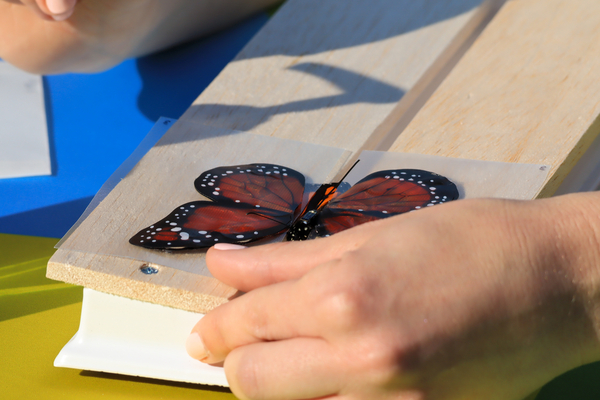LAKE BUENA VISTA, Fla. (May 12, 2025) – As a world-class leader in animal care, Disney continues to break ground using cutting-edge technology to improve animal care and help save wildlife. Disney’s scientists are pioneering the use of tiny radio telemetry tags to advance research on the North American monarch butterfly to help protect this iconic and cherished species.
This research, which takes place in the theme park for EPCOT visitors to see, is facilitated at Butterfly Landing presented by AdventHealth during the EPCOT International Flower & Garden Festival. Data gathered during the festival will be shared with facilities across the nation through the Association of Zoos and Aquariums (AZA) Saving Animals From Extinction (SAFE) program, focusing on the protection of the North American monarch butterfly species. Over the past two decades, monarch numbers in North America have declined, prompting the U.S. Fish and Wildlife Service to join state and federal agencies to take steps to conserve the monarch butterfly.
Disney is leading the collection of research on monarch butterfly migration patterns and feeding behaviors to help maintain a healthy, genetically diverse, and sustainable species population for the future. The mini radio telemetry tags are gently and carefully attached to the butterfly’s wing by scientists for a better understanding of migration patterns and the monarch’s preference for different milkweed. The tags are roughly the same size as a tiny grain of rice and tracks radio waves, similar to the technology used in phones and GPS.
The technology allows researchers to track the butterfly’s movements so we can learn more about their preference for different types of milkweeds. A major threat to the monarch butterfly species is their increasing exposure to a parasite commonly known as OE, which occurs when monarch butterflies feed on tropical milkweed. While native milkweed dies in the winter, tropical milkweed does not. When monarch butterfly larvae hatch on the tropical milkweed leaves, they ingest high levels OE. Infecting monarchs, the debilitating OE parasite negatively impacts almost every aspect of butterfly life, and research estimates that about 80% of Florida monarchs are exposed to OE. Disney Conservation Director Dr. Zak Gezon is the Program Lead for the AZA’s SAFE program for the monarch butterfly, which has been adopted by over 100 other AZA-accredited facilities nationwide. The trailblazing SAFE program for monarchs seeks to recover and sustain monarch populations by fostering healthy breeding and migratory environments in addition to safe places to be dormant for the winter. It also strives to inform how facilities can provide the best habitat for the monarch butterfly so they can avoid setbacks like OE. Guests can see the research in action inside Butterfly Landing at the EPCOT International Flower & Garden Festival, which runs through June 2.
For more information on conservation efforts around Walt Disney World Resort, visit WDWNews.com.
